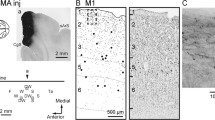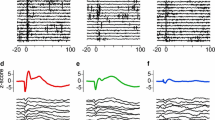Summary
The functional organization of a cortical efferent system controlling contralateral distal forelimb muscles was examined in monkeys using the method of intracortical microstimulation (ICMS). The results obtained are:
-
1.
Thresholds of stimulation for producing contraction of contralateral distal forelimb muscles were much lower (less than 1/100) in the depth of the cortex than on the surface.
-
2.
These low threshold spots were confined to a small region of the cortex (hand area) and ICMS with the same strength in the neighboring cortex did not produce contraction from any part of the body.
-
3.
Low threshold spots for a given movement were distributed along the direction of radial fibers within the gray matter constituting a columnar shape.
-
4.
Within a given columnar efferent zone, the thresholds were lower in the deep layer (V) than in the superficial layers.
-
5.
Each efferent zone had a sharp boundary, and frequently overlapped with another efferent zone which produced an opposite movement.
-
6.
Efferent zones controlling various movements of a joint were located close together and zones projecting to proximal muscles were located more rostrally than those projecting to distal muscles.
-
7.
These efferent zones constitute a fine mosaic organization within the depth of the cortex and functional significance of the organization was discussed in relation to the pyramidal tract.
Similar content being viewed by others
References
Asanuma, H., Sakata, H.: Functional organization of a cortical efferent system examined with focal depth stimulation in cats. J. Neurophysiol.30, 35–54 (1967).
—, Stoney, S.D., Jr., Abzug, C.: Relationship between afferent input and motor outflow in cat motorsensory cortex. J. Neurophysiol.31, 670–681 (1968).
— —, Thompson, W.D.: Characteristics of cervical interneurones which mediate cortical motor outflow to distal forelimb mucsles in cats. Brain Res.27, 79–95 (1971).
—, Ward, J.E.: Patterns of contraction of distal forelimb muscles produced by intracortical stimulation in cats. Brain Res.27, 97–109 (1971).
Brooks, V.B., Asanuma, H.: Recurrent cortical effects following stimulation of medullary pyramid. Arch. ital. Biol.103, 247–278 (1965).
Davies, P.W.: Chamber for microelectrode studies in the cerebral cortex. Science124, 179–180 (1956).
Denny-Brown, D.: Motor mechanisms-Introduction: The general principles of motor integration. In: Handbook of Physiology. Amer. Physiol. Soc. Vol. 2, pp. 781–796 1960.
Fritch, G., Hitzig, E.: Über die elektrische Erregbarkeit des Großhirns. Arch. anat. Physiol. wiss. Med.37, 300–332 (1870).
Fulton, J.F.: Physiology of the nervous system, pp. 392–420. New York: Oxford University Press 1949.
Glees, P., Cole, J.: Recovery of skilled motor functions after small repeated lesions of motor cortex in macaque. J. Neurophysiol.13, 137–148 (1950).
Hern, J.E.C., Phillips, J.C., Porter, R.: Electrical thresholds of unimpaled corticospinal cells in the cat. Quart. J. exp. Physiol.47, 134–140 (1962).
Kennard, M.A.: Reorganization of motor function in the cerebral cortex of monkeys deprived of motor areas in infancy. J. Neurophysiol.1, 477–496 (1938).
Klüver, H., Barrera, E.: A method for the combined staining of cells and fibers in the nervous system. J. Neuropath. exp. Neurol.12, 400–403 (1953).
Kuypers, H., Brinkman, J.: Precentral projections to different parts of the spinal intermediate zone in the Rhesus monkey. Brain Res.24, 29–48 (1970).
Landgren, S., Phillips, C.G., Porter, R.: Cortical fields of origin of the monosynaptic pyramidal pathways to some alpha motoneurones of the baboon's hand and forearm. J. Physiol. (Lond.)161, 112–125 (1962).
Lawrence, D.G., Kuypers, G.H.J.M.: The functional organization of the motor system in the monkey. I. The effects of bilateral pyramidal lesions. Brain91, 1–14 (1968).
Liddell, E.G.T., Phillips, C.G.: Thresholds of cortical representation. Brain73, 125–140 (1950).
Liu, C.N., Chambers, W.W.: An experimental study of the cortico-spinal system in the monkey (Macaca mulatta): The spinal pathways and preterminal distribution of degenerating fibers following discrite lesions of the pre- and postcentral gyri and bulbar pyramid. J. comp. Neurol.123, 257–284 (1964).
Phillips, C.G.: Motor apparatus of the baboon's hand. Proc. roy. Soc. B.173, 141–174 (1969).
Rosén, I., Asanuma, H.: Organization of the projection from motor cortex to distal forelimb muscles in the monkey. Proc. XXV int. Congr. Physiol. Sci.9, 411 (1971).
— —: Peripheral afferent inputs to the forelimb area of the monkey motor cortex: Input-output relations. Exp. Brain Res.14, 257–273 (1972).
Sherrington, C.S.: On nerve-tracts degenerating secondarily to lesions of the cortex cerebri. J. Physiol. (Lond.)10, 429–432 (1889).
Sholl, D.A.: A comparative study of the neuronal packing density in the cerebral cortex. J. Anat. (Lond.)93, 143–158 (1959).
Stoney, S.D., Jr., Thompson, W.D., Asanuma, H.: Excitation of pyramidal tract cells by intracortical microstimulation: Effective extent of stimulating current. J. Neurophysiol.31, 659–669 (1968).
Takahashi, K., Kubota, K., Uno, M.: Recurrent facilitation in cat pyramidal cells. J. Neurophysiol.30, 22–34 (1967).
Tower, S.S.: Pyramidal lesion in the monkey. Brain63, 36–90 (1940).
Author information
Authors and Affiliations
Rights and permissions
About this article
Cite this article
Asanuma, H., Rosén, I. Topographical organization of cortical efferent zones projecting to distal forelimb muscles in the monkey. Exp Brain Res 14, 243–256 (1972). https://doi.org/10.1007/BF00816161
Received:
Issue Date:
DOI: https://doi.org/10.1007/BF00816161




